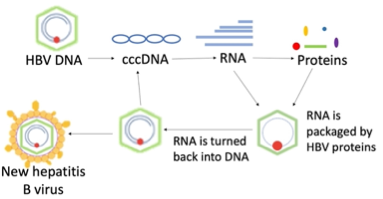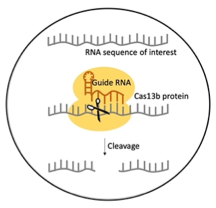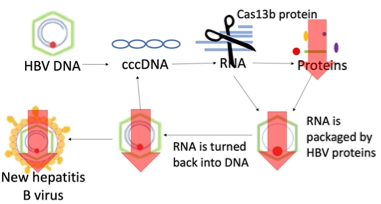Hi everyone! My name is Laura and I am in my final year of my PhD. My PhD has focused on developing a potential new treatment for hepatitis B virus, using a protein called CRISPR-Cas13b.
Hepatitis B virus is a DNA virus. The DNA is first converted to cccDNA and this cccDNA is read by the cell to make RNA. These RNAs code for the HBV proteins. One of these RNAs is also packaged by some of HBV proteins and turned back into DNA to form a new hepatitis B virus, or make more cccDNA.

Figure 1. HBV lifecycle
High levels of some of the HBV proteins have been shown to exhaust the immune system, making it ineffective at controlling the HBV infection. Some studies have shown that if these proteins are reduced, this allows for a more effective immune response that may clear the virus. The HBV RNAs are not targeted by current HBV treatments, and therefore, represent a novel target for new treatments.
The CRISPR-Cas13b protein is naturally used by bacteria to target the RNA of invading pathogens, to prevent the bacteria from being infected. Studies have shown that the CRISPR-Cas13b protein may be used in mammalian cells and may be repurposed to target different human viruses, such as Influenza and SARS-CoV-2. This is achieved by designing a guide sequence, known as a guide RNA, that is complementary to the RNA sequence that we wish to target. The guide RNA interacts with the CRISPR-Cas13b protein and guides the protein to the correct target sequence to cut the target RNA. Once the RNA is cut, it can no longer make the proteins that it codes for.

Figure 2. Mechanism of Cas13b
During my PhD, I have repurposed the CRISPR-Cas13b protein to target the RNAs of hepatitis B virus to reduce the expression of the HBV proteins and replication. We designed guide RNAs that targeted all of the HBV RNAs in regions that were conserved across multiple HBV genotypes. We then tested whether we could use CRISPR-Cas13b to target and reduce HBV proteins and replication in cell culture models in the laboratory, with very promising results. We also confirmed that our guide RNA sequences could target multiple HBV genotypes. We are currently optimising the delivery of CRISPR-Cas13b and will test CRISPR-Cas13b in combination with current therapies. We believe that CRISPR-Cas13b may be a potential new treatment for HBV to target the HBV RNAs to reduce the production of the HBV proteins, and to reduce HBV replication.

Figure 3. Cas13b targeting HBV RNAs to reduce proteins and HBV replication